An appreciation of normativity
Examples of appreciating normativity
$$
$$
- Commodity fetishism (Marx)
“a form of reification, commodity fetishism presents economic value as inherent to the commodities, and not as arising from the workforce, from the human relations that produced the commodity, the goods and the services.”

. . .
How does it come about that this arrow ⟼ points? Doesn’t it seem to carry in it something besides itself? “No, not the dead line on paper; only the psychical thing, the meaning, can do that” – That is both true and false. The arrow points only in the application that a living being makes of it. This pointing is not a hocus-pocus which can be performed only by the soul… “When we mean something, it’s like going up to someone, it’s not having a dead picture (of any kind).” – Philosophical Investigations
. . .
One is called out by Marx: (read quote) E.g. grammar of “value of the house” makes it seem like property of the house. People used to argue about the value of gold vs silver as if it were a fact like their densities. Social consequence: people are not as willing to envision alternate economic paradigms, given that they are facts about the world.
(…) The latter example asks us to consider the arrow symbol and the fact that it ‘points’ to the right. Despite the grammar of “it points”, it’s us who take it to be pointing.
(…) It’s also important to not overdo things with normativity: taken too far, one ends up with “it’s all relative” attitudes which promote these bad things listed here. This is the bad kind of post-modernism. The crux of this talk will be about how we can be good post-modernists: fully embracing normativity without sliding into either the fetishistic or the relativistic extreme. As a constant reminder to not do this, I’ll keep this warning at the top of each subsequent slide.
Map metaphor better appreciates normativity
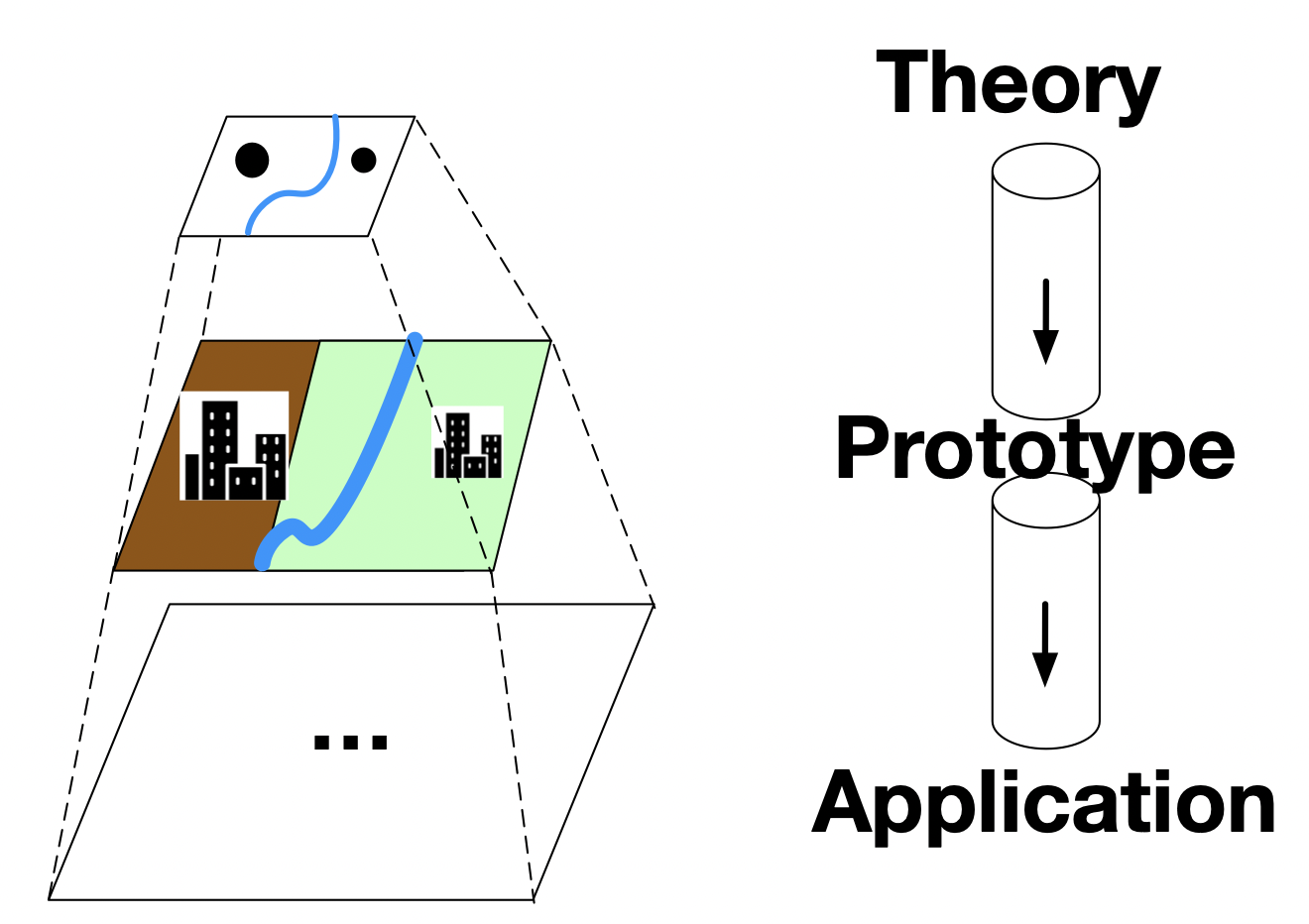
. . .
To some extent, our understanding of the world depends on us
- Our interests (which aspects the map foregrounds)
- Our limitations (what we are capable of recording)
To tie this to Topos, recall that Shaowei’s inaugural TTT had a pipeline metaphor from theory to applications. Brendan offered another metaphor of overlaying maps to avoid evoking a linear progression.
(…) This has some advantages. (read) This was relevant for Topos, as we accomplish our mission better when we have a back-and-forth with those we seek to help (e.g. epidemiologists) as opposed to us just providing a mathematical framework they ought to obey. After giving some historical context, I’ll try to talk about how we can further improve this metaphor.
Historical context of map metaphor
Representation is made explicit by Descartes in mathematics and philosophy.
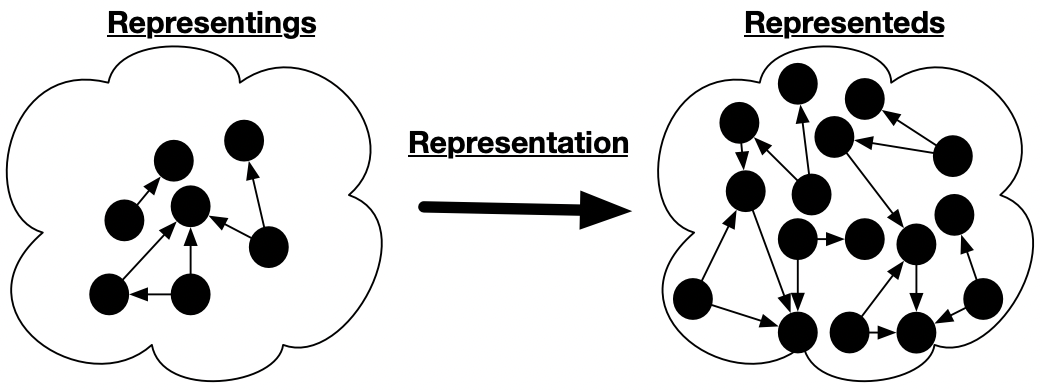
. . .
Good consequence: attitude towards norms becoes more critical.
. . .
Bad consequence: world divided into two fundamental types of things
| Representings | Representeds |
|---|---|
| Perception | Reality |
| Social construction | Nature |
| Values / norms | Facts |
| Propositional beliefs | Things |
- Mind/body problem: How is the mind affected by real stuff / how can the mind cause real events?
- Norm/fact problem: How can we know about norm stuff? (in the way we know about mass) Where in the world of natural science do we find these things?
This improvement of metaphor parallels a development in Western thought. The Enlightenment tought us to think of our relationship to the world in representational terms, rather than resemblence (i.e. sharing properties). This was made explicit by Descartes, who was facinated by how geometric figures can be represented by algebraic concepts.
(…)This recognition of how much our understanding depends on us led to a more critical attitude towards authority: to the extent things are perspectival rather than objective, we naturally ask “is this the right perspective?” Good: the democratic consequences. (yada yada yada French Revolution)
(…) Bad: The map metaphor beckons us to think about there being fundamentally two different kinds of things. A line is drawn between things which by their nature are representings and those which are representeds. We’re alienated from the world because we’re separated by some medium of representation, which means people who think deeply will at first radical skeptical doubts. Here are two examples of problems.(read) This skepticism manifests at Topos when Evan sees scientific modeling always being done within a framework, but then worries how we can know the accuracy of that framework? Seeking a general, metaphysical answer to that question stems from the map metaphor.
There are a number of ways of confronting these problems, and looking at the history of philosophy we see they all have controversy. Some want to deal with the chasm by trying to live completely on one side or the other (everything is just ideas, everything is just atoms whizzing by). Or denying it, saying we do have some beliefs / values which correspond to something in Reality.
Distinction: theoretical and practical reason 1
| Theoretical | Practical | |
|---|---|---|
| Motivating question | What are we to believe? | What are we to do? |
| Goal | The True (correct beliefs) | The Good (desirable actions) |
| Reality | … is found | … is made |
| Direction of fit | World → Mind | Mind → World |
. . .
Enlightenment lesson: practical norms come from us (not God / nature).
Moving beyond the map metaphor requires recognizing theoretical norms also come from us.
This seems radical because there is an important sense in which certain theoretical norms (“if I drop this marker, it will fall”) are dictated by the world, that certain propositions have truth which is found, not made.
It’s worth fleshing out the extent to which modern (post-Enlightenment) society appreciates norms. This requires distinguishing what is called “theoretical” norms and “practical” norms.
This is a bit coarse, there are some theoretical norms (like Occam’s Razor) which are ambiguous as to whether they come from us or the world.
This concludes the fleshing out of the map metaphor. To move beyond it into a metaphor that doesn’t suffer from the problems, I’ll need to move to a legal setting.
The Enlightenment
Vanguard of society shifts from the priest/king to the scientist.
French revolution / social contract theory - authority to govern comes from the people, rather than kings.
Recognition that source of practical norms comes from us, rather than God or nature.
Two problems:
Humanity’s theoretical reasoning still seen as normatively governed by something non-human.
Alienation: if norms come from us, how can they be rationally binding?
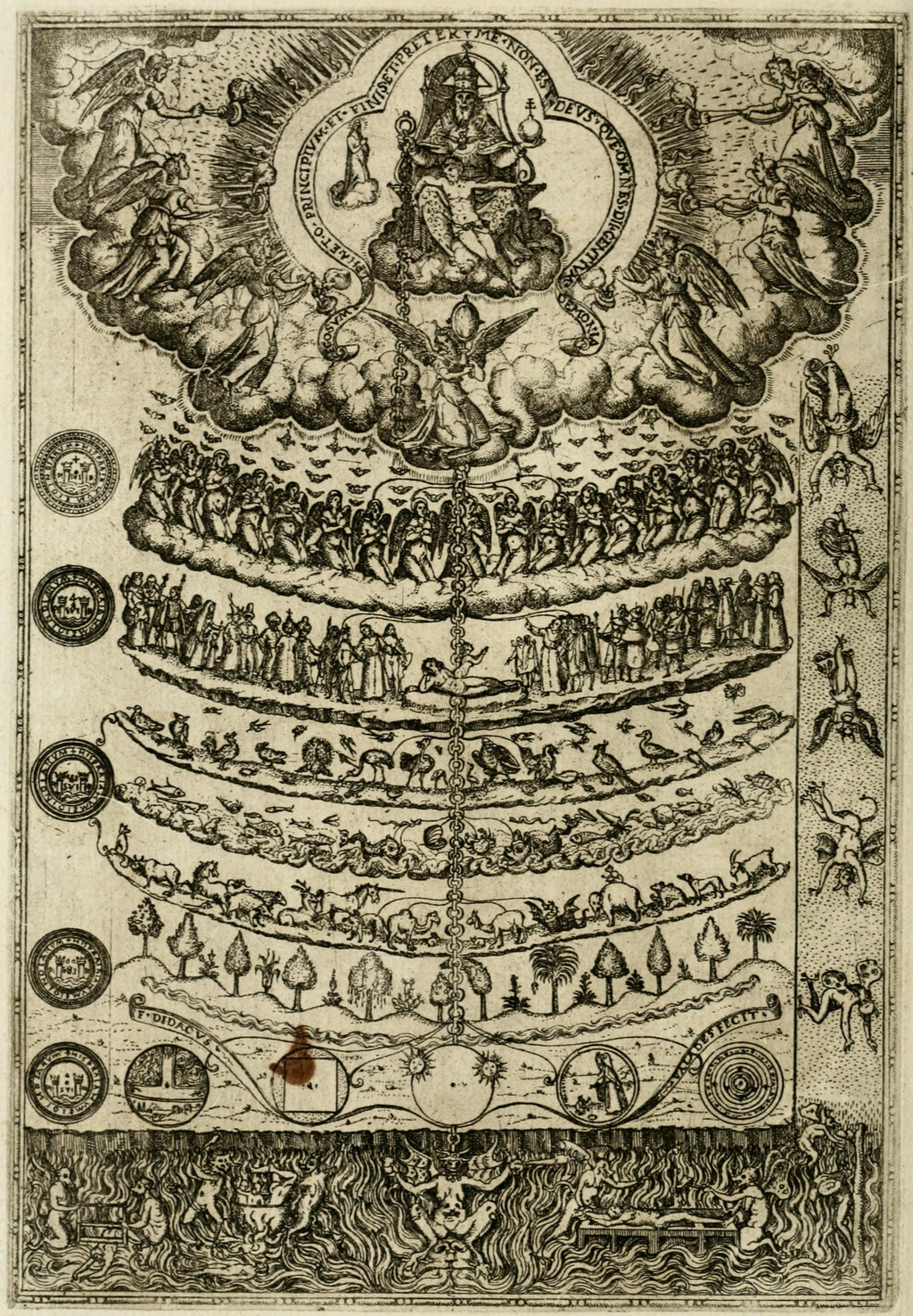
Ambiguity in legal interpretations
“Employers cannot discriminate on the basis of sex” – Equal Pay Act (1963)

Ambiguity is resolved by authority of judge. But where does this authority come from?
. . .
- We want reasons why the meaning of the law dictates the verdict.
. . .
- No mechanical way to prove the verdict follows from the law, so is the judge’s authority simply the violent power of the state?
Legal settings force us to confront that meanings are ambiguous. Consider this example: does explicit discrimination on a trait correlated with sex count as violation of this law? Our map metaphor would make it seem like the statement of the law picks is syntax for a semantic proposition, and that semantic proposition perhaps picks out the subset of possible worlds in which the law is violated or not. But for reasons I gave in my other talk, natural language doesn’t work this way. The dream of the judge’s job being a purely mechanical task is a false hope. As the next slide shows, there is a serious school of legal thought which takes even this hope for rational authority to be a false hope.
Legal formalism vs legal realism
| Legal Formalism | Legal Realism | |
|---|---|---|
| What is the goal of legal theory? | Determine correct procedures for determining the relevant facts and applicability of statutes. This is a normative ideal; there is a right and wrong way to do it. | Describe what judges really do, which is contingent on their cultural upbringing, personal biases and beliefs, mood, etc. |
| Does the law settle the verdict of the case? | Yes, law is determinate (if the judge is doing their job correctly). | No, law is indeterminate. |
| The correct verdict | … is found. | … is made. |
| Problem arising from norm-fact distinction | How does the judge get in contact with the meaning of the law? | Skepticism about norms being real, as they don’t fit into the natural world. |
The two dominant schools are that the facts of the case and the law do together determine and objective verdict which is the judge’s responsibility to find, or a more nilhilistic attitude that the judge is just a flesh-and-blood human whose decisions are as influenced by ideals as it is what they had for breakfast that morning. Thus judge’s rulings are authoritative simply due to their political power, and the law itself is indeterminate. This legal realism should seem similar to moral irrealism, whereas legal formalism is more like moral realism (reifying moral principles as perspective-independent entities). We can also tie this to the norm-fact distinction which comes from modernity’s map-metaphor.
Example: A judge rules on the Equal Pay Act . Legal formalist would say there actually was (or wasn’t) discrimination, and judge correctly (or incorrectly) responded to the evidence and applied the law The legal realist would analyze what happened as the judge exercised his power, but was motivated by personal sexism, or desire to be an activist, his professor … |
Common law: precedent
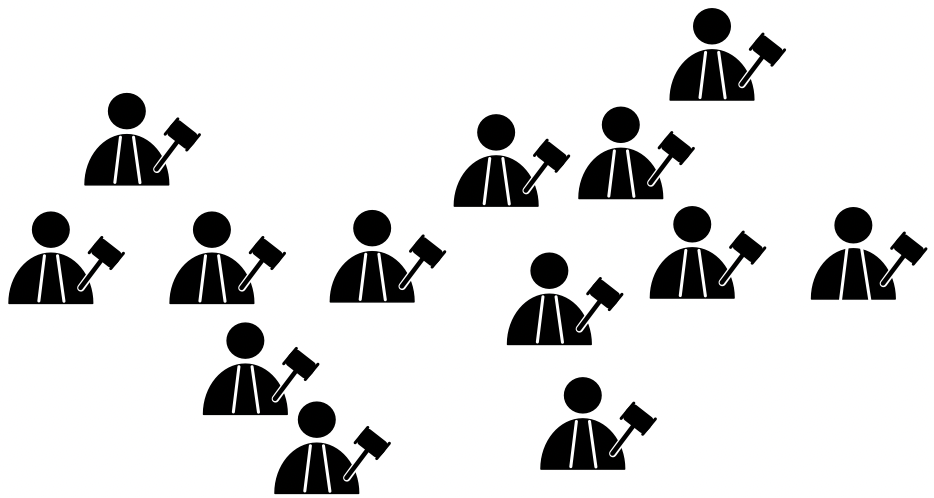
Let’s look more closely at how the judge gives their ruling (as they are not merely giving a verdict.) Once all the explicit definitions have been unpacked, judge’s rulings have the structure of something called “common law” or “case law” or “judge-made law”. Here, in resolving the meaning of an ambiguous term like “discrimination” or “reasonable” or “malice”, there is nothing the judge can appeal to for evidence other than rulings of past judges. But these data points aren’t all presumed to be good ones.
Common law: precedent
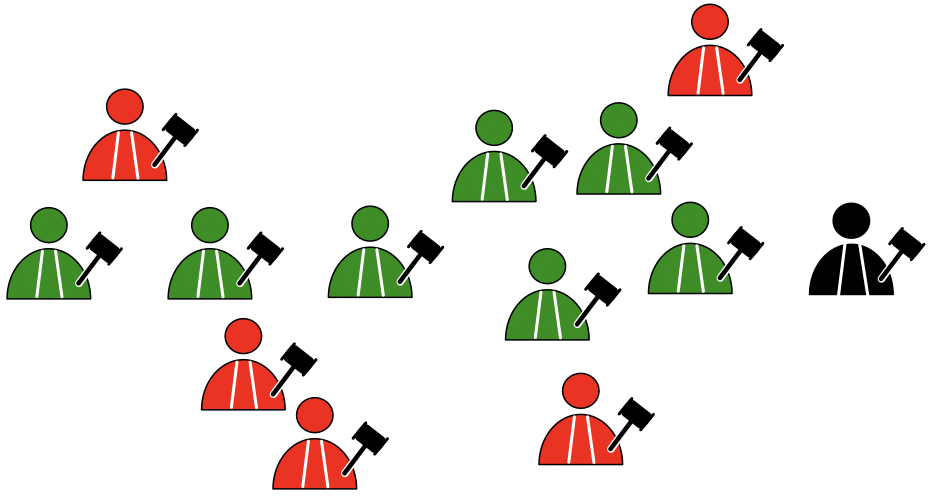
The judge identifies relevant past rulings, then some of these judges are seen as precedential (being responsive to the law, having made better decisions) and others as having been bad. One cannot just make this partition arbitrarily: one must talk about the objective law and its meaning and show how the good judges slowly came to discover the truth over generations, despite some missteps here and there.
Common law: operad of precedent
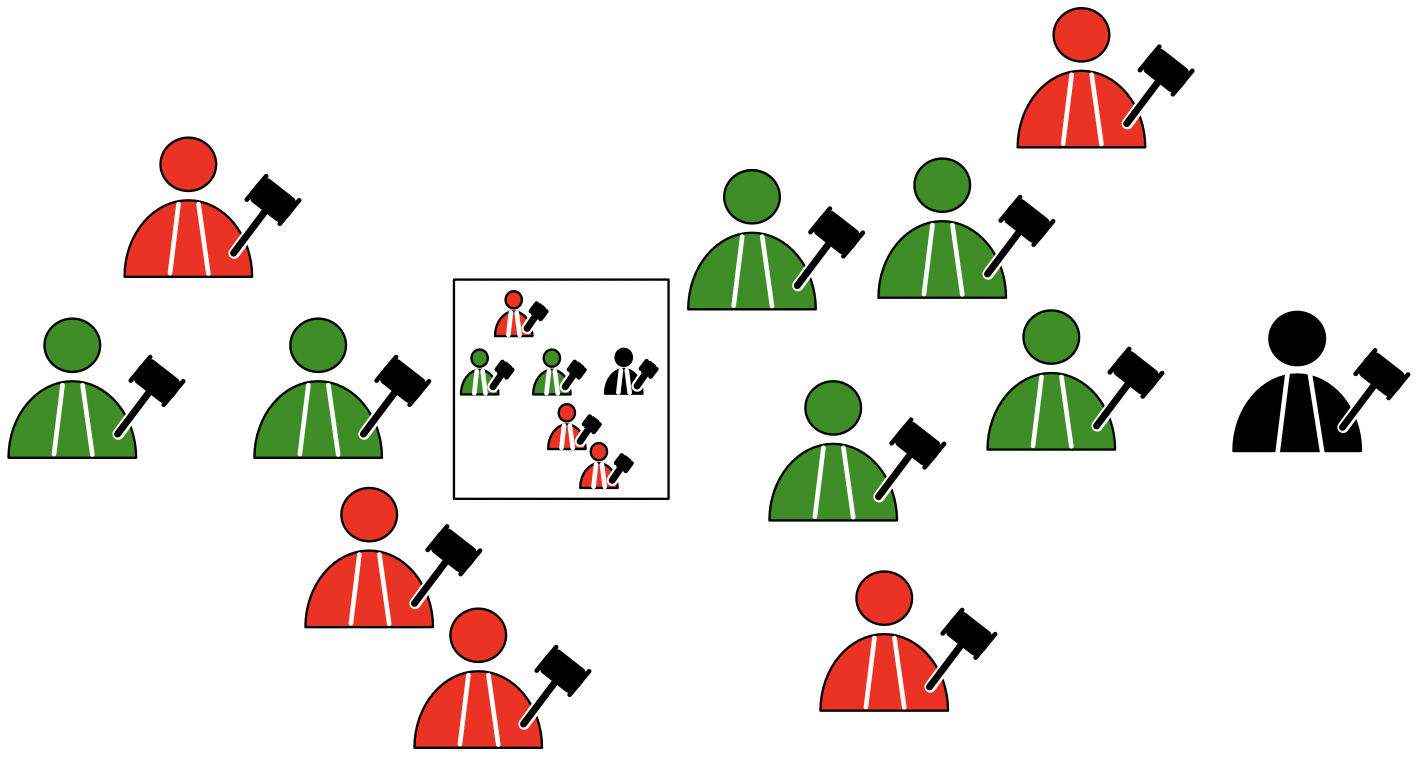
Each judge in the past has themselves made such a retrospective, rational reconstruction of the meaning of the law. It is their very own reconstruction that is judged as precedential or not precedential in the present judge’s reconstruction.
The impact of the present judge’s verdict will have a lasting impact only insofar as future judges look back and see this reconstruction as a good one. Past judges are authoritative over the present judge b/c the present judge has no alternative except their verdicts to appeal to in constructing a verdict. However, the present judge has authority over the past judges by regarding some as precedential but not others. Likewise, we have the same relationship but reversed to our present and future peers.
Common law metaphor for conceptual content
Rational reconstruction is a kind of making that is also a finding.
- Finding (theoretical reason, looking retrospectively): verdict cannot be framed as a choice; we tell a story where we find out which concept applications are precedential according to our understanding of the conceptual content.
. . .
- Making (practical reason, looking prospectively): we are making an action by interpreting the meaning in a particular way; this affects our peers (who have a responsibility to incorporate our usage into their verdict.)
. . .
Rational reconstructions give contingency the form of necessity.
- Necessity: Whether past judges explicitly realized it or not, their decisions were the result of (objective) norms which have always existed. (“discrimination”, “tort”, “malice” have actual/objective meanings, they are not just words)
. . .
- Contingency: maybe what I ate for lunch did in fact influence my reconstruction. That’s for future generations to decide.
So this story denies the problematic distinction between making and finding which we’ve seen come up repeatedly. It keeps the distinction, but the relation between the two is now not a mystery: it is the retrospective act of making a rational reconstruction that we think in terms of earlier actions being good or bad with respect to some feature of the world. But propsectively we know that future generations will take our reconstruction and judge it as either responsive or not to the genuine (i.e. in the world, non-perspectival) norm.
This can work as a metaphor because the procedure is all very explicit in the legal setting. Yet we can think of a process like this happening in any setting where we are interpreting meanings (this idea is Brandom attributed to Hegel).
Common law metaphor for conceptual content
Normative structure:
obedience / subordination

Normative structure: mutual recognition
authority only with correlative responsibility

. . .
This is no metaphor in describing the semantic content of legal terms. But we can use this metaphor to understand semantics generally, not just legal terms. One may be inclined to do this if one realizes:
- The tradition we’ve been born into takes the map metaphor for granted.
- The negative features of map metaphor are addressed by the common law metaphor.
- The virtues of the map metaphor are recoverable as a special case of the common law metaphor.
This is challenging obedience / subordination as the paradigm for normative relations (whether it’s the world over us, or us over the world).
Outline
- Uncontroversial examples of normativity
- Commodity fetishism, pointing of an arrow
- Pipeline vs map metaphor
- Problematic separation of norm and fact of the map metaphor
- Common law metaphor
. . .
- More controversial examples of normativity
- Definitions in mathematics
- The referents of ordinary speech and science
- The “success of science”
- The propositional contents of our thoughts
- The representational relation
So we saw how we can think of legal practice as normative (but not relativistic).
I want to spend the rest of the talk going over some other domains that we tend to think of as objective and show how we can think of them in a normative (but not relativistic) way.
Mathematics
Mathematicians work with definitions. They make statements which, if true, are true by virtue of the meanings of terms they use. This truth is independent of the attitudes of any human beings (or even of our understanding of the natural world).
- If someone tells you “I can prove this circle intersects with this line at three points,” then you reply “Then you must mean something different by circle, intersect, line, point, or prove.”
. . .
- The community has a notion of a Foo.
- Someone proposes a “symmetric Foo” (or a “2-Foo”, or a “monoidal Foo”).
- There is a sense in which they can define these to be whatever they want, but that is a very weak sense.
- A more robust sense is modeled off of common law example:
- One justifies their claim to the concept “monoidal Foo” by appealing to previous uses of “symmetric” and “Foo”.
- If the community vibes with this recollection, then it gets adopted.
- Sometimes even an honest effort (e.g. to define higher-order categories) is not judged to be precedential.
David, who agonizes about finding “the right name” for a new concept he discovers / makes, is doing math this way.
Mathematicians are able to more plausibly make a distinction between beliefs and meanings. But these are two sides of one coin: what we believe affects what we mean, and what we mean affects what we (ought) believe. Thus there is no mere “just making definitions” unless what you are defining has no inferential connection to any other concepts.
Referents in ordinary speech and in science
Paradigm of reference:
naming

Paradigm of reference:
inferential role

When all is going smoothly, a name suffices to determine meaning.
. . .
- Different people with incompatible claims about the same name are either in actual conflict or they are referring to different things.
- To the extent that we massively agree in our interpretations of a concept and cannot envision interpretation ever changing, the map metaphor is appropriate.
- This is the extent to which the chair in the room exists and is made sense of via the map metaphor.
But we also recognize often there are multiple parties vie for authority over a name. Or recognizing that someone in another context (cultural, historical) was talking about the same thing using a different name.
This is a point I’ll keep coming back to
Referents in ordinary speech and in science
Jones says “The witch who lives in the house at the end of the street really scares me.” We, not believing in the myth of witches, can have a couple of reactions to this:
- Jones referred to the woman who lives at the end of the street, and the fact he implicitly described her as a witch just betrays some false auxiliary belief he has about witches.
- Jones failed to refer to the woman at the end of the street because she isn’t a witch (since no witches exist).
. . .
False dichotomy induced by the map metaphor
Likewise for phlogiston:
| Phlogiston does not exist | Phlogiston refers to oxygen |
|---|---|
| Phlogiston was made (unlike oxygen) | Phlogiston was found (like oxygen) |
| “Phlogiston theory led to experiments that ultimately concluded with the discovery of oxygen.” | “Early experiments about oxygen concluded it had negative mass.” |
(…)One of these two quotes is actually from the wikipedia article, but both are possible.
Causal theories of reference and bottom-up semantic theories (which start with the primitive things that exist and their properties, then builds up the reason relations they stand in) require a sharp line between things that exist and don’t exist, whereas pragmatically we see no such line exists.
To talk this way about oxygen with negative mass is the same as talk of people thinking electrons orbit the nucleus (but were actually referring to the thing that is a cloud of probability density).
Takeaway: existence isn’t the sort of thing for which there is a fact of the matter.
A downside of map metaphor is that it makes it seem like our meanings hinge crucially on what actually exists or not. This is important for the case of science vs pseudoscience, because in our lunchtime conversations sometimes people draw the boundary between the two by considering whether or not one is referring to real things.
NOTE: Pluto / sour acid examples also drive home this point.
Distinguishing science
Across time, some people were “doing science” and other people were not.
People who did science were able to get what they want easier, all else equal.
Actions / practices are, by their intrinsic nature, either “scientific” or not.
We know this through common sense: you know it when you see it.
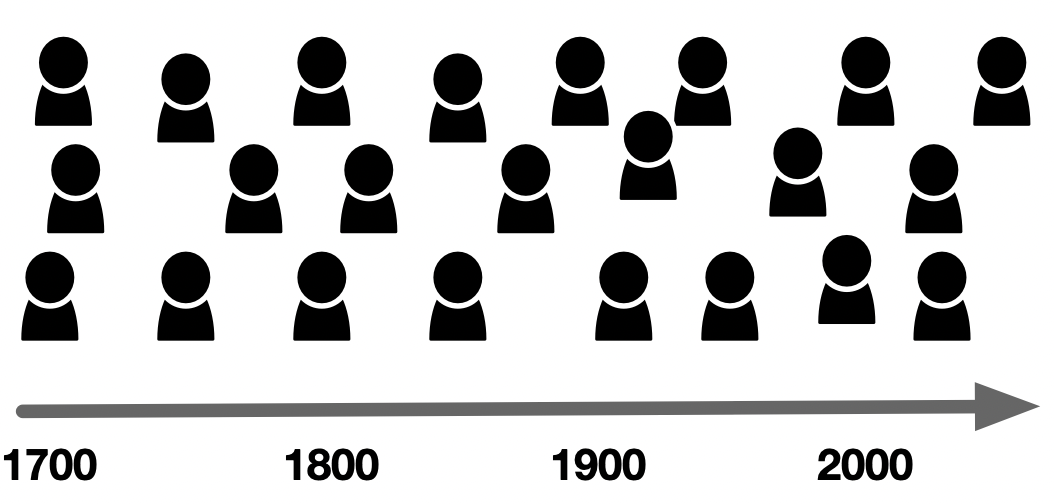
Naive story we tell ordinary people to get them to respect science
This is structurally similar to telling people: across time, some people were ‘good’ people and others were not.
Distinguishing science
Across time, some people were “doing science” and other people were not.
People who did science were able to get what they want easier, all else equal.
Actions / practices are, by their intrinsic nature, either “scientific” or not.
We know this through common sense: you know it when you see it.
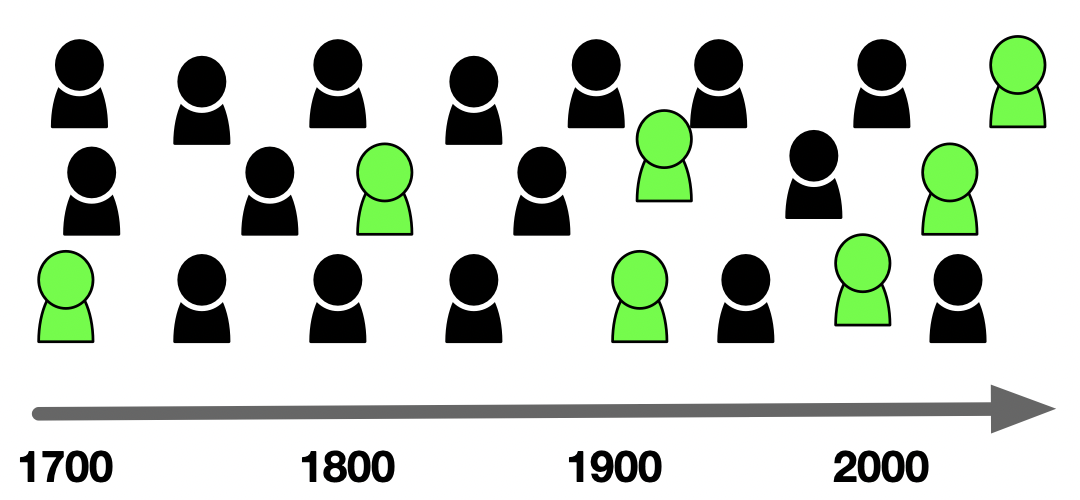
These people in green might be the people who objectively are doing science. We can use our present scientific theories to ask counterfactual questions and conclude that those green people would have an easier time getting what they want than the others.
This is the kind of thing you tell to a child or someone who doesn’t already agree to tautologies like “science is good”.
Distinguishing science
We can ask the metaphysical question “what makes an action / practice truly scientific?”. We look for a definition.
- The definition adjudicates all past and future uses of the concept scientific.
- The definition reduces terms in a problematic vocabulary to an unproblematic vocabulary
- People disagree on what they consider unproblematic (e.g. natural science, ordinary language, FOL, ZFC)
- One has to take some vocabulary as unproblematic to get off the ground.
The normative structure of a definition like this is the authority/subjugation model.
. . .
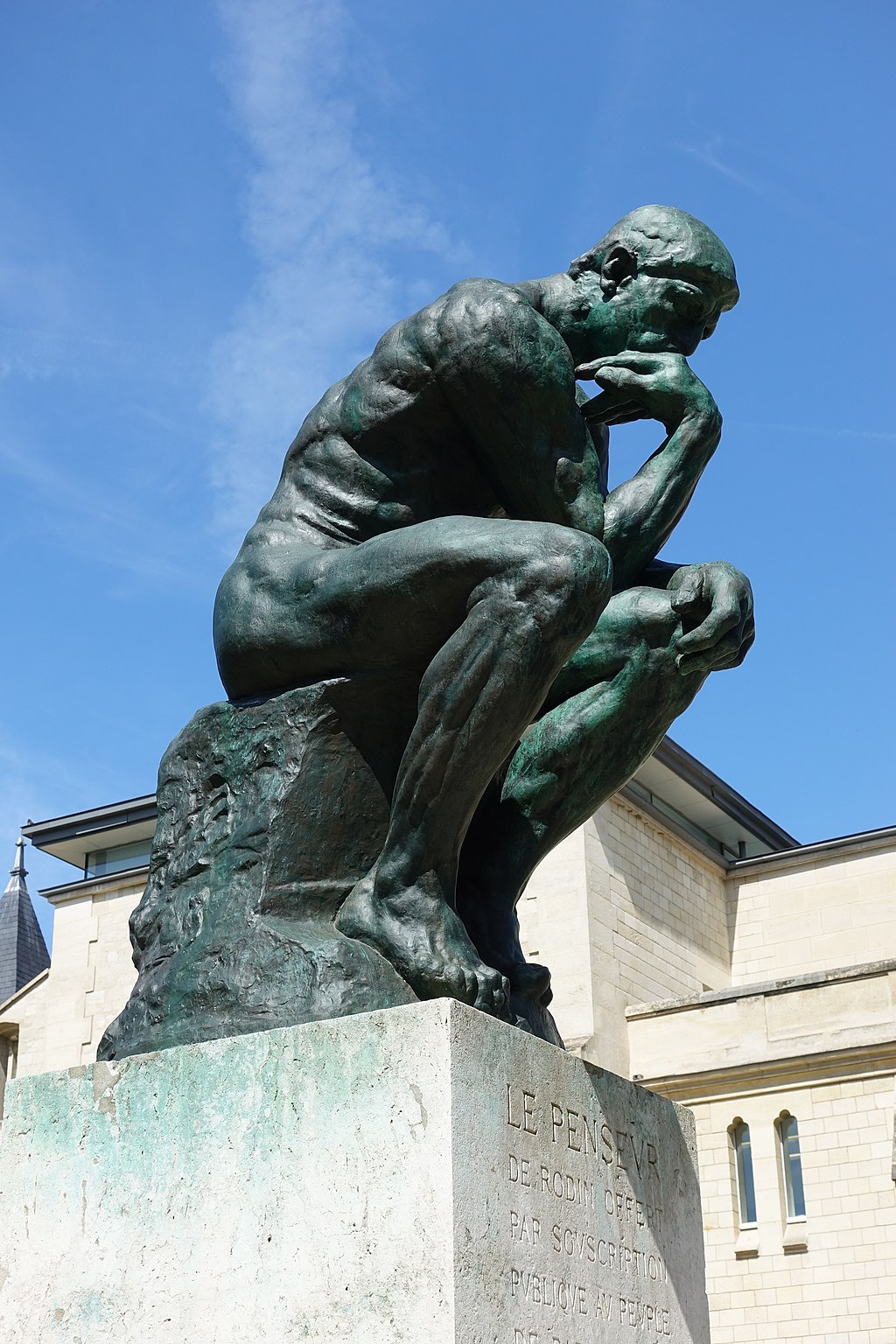
“I have a very strong intuition that what the majority of ‘scientists’ do science.”
“Was alchemy science?” … “Scientific terms must refer to the objective world.”
“Then the ‘scientists’ who theorized about phlogiston weren’t doing real science.”
“But we have no way of knowing if our theories now will end up like phlogiston…”
Etc.
It was proposed at lunch the other day that pseudoscience was something that went through the motions of science but devoid of content (by which I interpret this to mean: its terms don’t refer to real things). This is precisely the attitude I want this talk to argue against: you want to distinguish things structurally, not by essence or reference.
Distinguishing science

Popper redescribed what science is with falsification theory.
- Influential: cleanly explained earlier partitions of ‘science’ from ‘non-science’.
- Took science to be a different thing, thereby changed what science was.
. . .
Kuhn redescribed what Popper (and previous users of the concept) were doing.
- Kuhn drew a distinction between revolutionary and ordinary science: He was able to draw the partition different from Popper while still seeing Popper’s verdict as precedential (Popper wasn’t just totally wrong; he was responding to science-as-redescribed-by-Kuhn but was confused without the helpful distinction).
Caveat I’m not well-read on history of philosophy of science.
(Reminder: rational reconstruction is a making which is also a finding)
What is science can be thought of as determined by the common law metaphor. Popper and Kuhn both gave influential redescriptions. Science is successful in part because we choose who counts as scientists, and our criteria includes success (it does not solely consist in this, though - we have other norms we have to be responsive to when drawing the line between science and non-science).
Distinguishing science
We might presently take a stance on the history of science-like enterprises, e.g.:
- Alchemy (not science)
- Phlogiston (not science)
- Orbiting electron model (science)
- Nutrition (not science)
- Physics (science)
- Astrology (not science)
. . . We must give reasons, and not appropriately tying into previous uses of the term ‘science’ (as judged by future peers) means we fail to connect to the concept of “science” at all. We remain openminded to the possibility that future generations in their greater wisdom can make sense of what the field of nutrition was doing as tracking some independent norm.
. . .
When Evan fleshes out a “core logic of science”, he is making a rational reconstruction of the concept of science. This is a good and practical thing, as it will lead to a standard for legible science.
The relativist is still in the modern paradigm, but just denies that we can answer the metaphysical question of what is the right definition for science.
There are some rules to the game - in order to redescribe a concept one must rationally reconstruct it.
This is no problem if we reject the authority/subordination model of definitions (which makes definitional evolution an extra-logical affair).
Normative character of intentionality in general
A mother lets me watch her kids and says to me: “Show the children a game.” When she returns, she sees me teaching them to gamble with dice. She angrily exclaims, “I didn’t mean that sort of game!” – Philosophical Investigations
. . .
- Map metaphor tempts us to find in the structure of the intent in the mother’s brain state at the time she issued the command
- if this isn’t possible, deny the mother was right
- Map metaphor tempts us to treat cognitive contents as part of some monotonic logic
- if this isn’t possible, deny the her rationality.
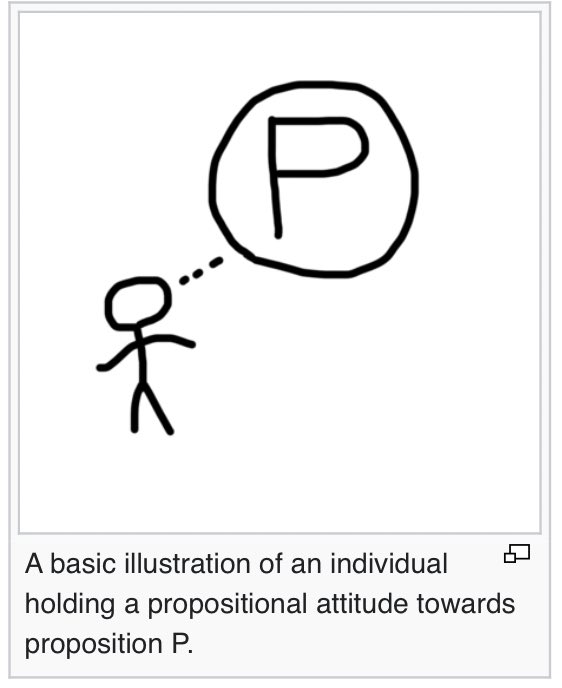
. . .
Likewise, we can make sense of Bertrand Russell asking if Plato’s discussion of “part” and “whole” was referring to the \(\epsilon\) or the \(\subset\) of set theory (or if Plato was conflating the two).
. . .
What someone is referring to depends both on us and on them.
There’s a Cartesian picture of our brains being little boxes which store the propositions we mean inside. There’s a hope that sufficiently analyzing a scientific description of the brain would reveal those propositions. But consider this very natural example of how we use “to mean”. (read quote)
Consider this in the context of Sophie’s multiscale dynamics project of analyzing the brain (in isolation) in terms of behavior of neurons.
I think the preclusion of gambling from the mother’s command stems from a cultural fact about the society she lives in. To do otherwise would be fetishization in the Marxist sense.
So now we can salvage my interpretation of Evan’s earlier claim which had a lot going for it about pseudoscience not having terms which refer to real things. If we understand reference in this normative way, we avoid fetishizing our interests as features of the natural world.
Representation as a normative relation

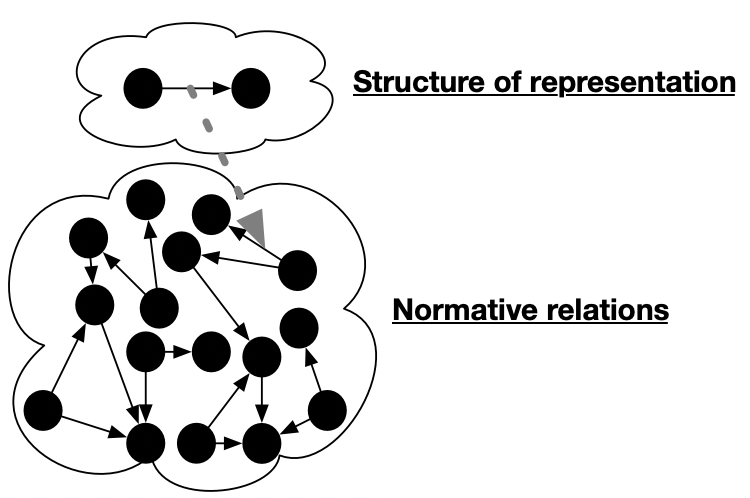
. . .
Representation itself can be thought of in terms of normativity. When \(A\) represents \(B\), it means that:
- \(A\) is responsible to \(B\)
- \(B\) has authority over the correctness of \(A\).

. . .
Previous examples have shown that we oughtn’t ground the meanings of statements in terms of representation. But can we do it sometimes, or is representation an irredeemable concept? (Rorty / Huw Price think so).
But we can salvage representation? It’s very helpful for explaining success of communicative practices (e.g. science).
Shopping cart example: the contents of the shopping cart are responsible to the shopping list. But the spy’s list is responsible to the shopping cart.
Conclusions
Revolutionary math and science (and politics)
- Requires a capacity to recognize how things which appear objective are in fact subjective.
- This is the kind of thing we want to do at Topos.
. . .
Normative character of definitions:
- By tying our definitions to concepts which have an inferential role in our language practices, they have an intrinsic normative character.
. . .
Inferentialist semantics rather than representational semantics:
- Unpacking meaning in terms of rational reconstructions of a tradition of its use (meaning of a word coming from its role in this practice, rather than its referent) is in line with the structuralist ethos of category theory.
- It likewise has a built-in distrust of semantic-web-esque ambitions in its explicit openness to future revision.
All of the takeaways I think are things we agreed on from the start. The idea is that these are more natural / less things we have to work hard to grasp when we adopt this different philosophical outlook.
Conclusions
Common law metaphor for conceptual content
- Objective when viewed retrospectively, but also historically and socially-determined.
- Not relativism: rational reconstruction must frame the past as progressively moving towards some perspective-independent ideal.
- Not arbitrary: our rational reconstructions are at risk of being ruled non-precedential if we aren’t appropriately responsive to the ideals of the future ‘judges’.
- Yet these judges aren’t arbitrary either - they can only appeal to our usage.
- It foregrounds a mechanism by which we can change institutions: by getting other fields to redescribe their own intellectual history
- e.g. “They were doing category theory all along, even if they did not know it.”
. . .
Map metaphor seduces us to seek the right definitions rather than stay flexible.
More reading
- Main source:
- Related commentary of mine:
This presentation has just been a rehash of ideas of Rorty’s / Brandom’s which I have found helpful.